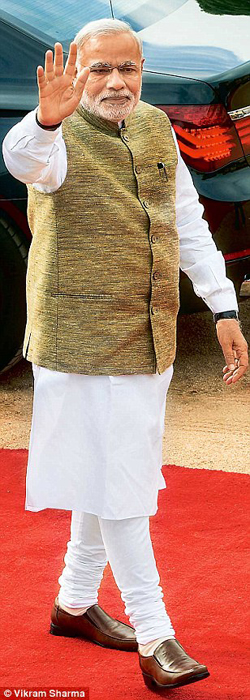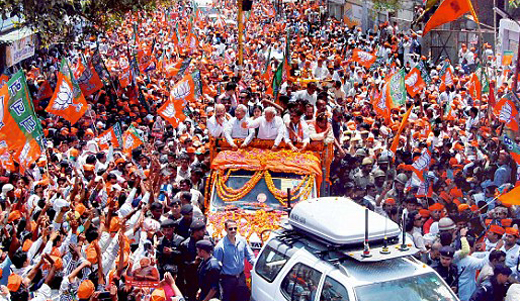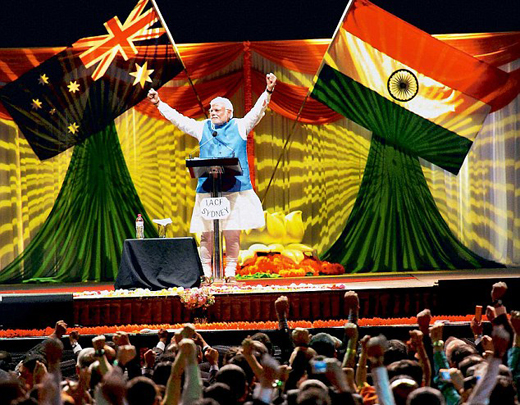How Modi scripted India’s future in 2014
How Modi scripted India’s future in 2014
mangaloretoday.com/ dailymail
By Manoj Joshi
The year 2014 could well have been an exceptional year for modern India’s political history.
This is the year when Narendra Modi, a rank outsider and a political outcast in 2002, stormed his way to power as the prime minister of the country, at the head of the first government since 1989 to have a majority of its own.
 By the end of the year, through significant victories in Assembly elections in Maharashtra, Haryana and Jharkhand, and the impressive showing in Jammu & Kashmir, the Modi phenomenon had steamrollered the Opposition.
By the end of the year, through significant victories in Assembly elections in Maharashtra, Haryana and Jharkhand, and the impressive showing in Jammu & Kashmir, the Modi phenomenon had steamrollered the Opposition.
The question in all minds is whether the Modi effect will continue to operate in 2015. Will the party, which today has 1,058 members of the Legislative Assembly in the various states of the country, as compared to 949 of the Congress, score in Delhi and Bihar Assembly polls?
But equally important is the question of whether Modi will be able to initiate his development agenda, or be derailed by the Vishwa Hindu Parishad, Bajrang Dal and assorted Right-wing radicals whose goals are nothing short of converting this huge and diverse country into the homogenous politico-religious entity of their twisted imagination.
Unlike the shell-shocked Congress, which seems set to decline, the BJP’s Bihar opponents - bitter rivals Nitish Kumar and Lalu Prasad - have actually reunited.
Further, the election will be conducted at a time when the effect of the Modi bulldozer will be wearing off. If the BJP wins Bihar, it will target West Bengal and Assam in 2016 and, then the biggest prize of them all - the Samajwadi Party in Uttar Pradesh in 2017.
Notwithstanding the Bihar combination, Modi’s biggest challenge seems to be from within. The struggle is between those who believe that Modi’s mandate is to bring a governance revolution in the country which would lead to a clean, corruption-free and prosperous - and others, who think that the mandate was to assert the primacy of the country’s majority community by reconverting minorities and reforming and restructuring education.
But as 2014 ended, it was clear that the message of good governance was being drowned out by the cacophony of the Hindu right-wing. To that end, they have launched a guerrilla war challenging conversion of Hindus, even while attacking Bible study classes, harassing Christian congregations and preventing interfaith marriages.
Modi himself has given ambiguous signals by derailing Christmas Day through his call to celebrate it as Good Governance Day.
Modi’s dilemma is palpable. Emotionally and intellectually, he is very much part of the Sangh Parivar. But as the chief minister of Gujarat he has grown and outgrown the narrow confines of ideology and understands the virtues and compulsions of pragmatism.
At one level, he understands the importance of the Parivar elements in his victory. It is clear that he understands the dangers posed by the monofocal agenda of the Sangh. Whenever the RSS and its Parivar has obsessed on conversion or reconversion, Modi has sought to take the high ground and promote “secular issues” - cleanliness through the Swachh Bharat campaign, ‘Make in India’ to promote manufacturing, and so on.
In his radio talks, he has spoken on a variety of issues such as drug addiction, and in his Independence Day address, he also took up the theme of women’s empowerment.
In 2015, Modi and the BJP have to show that it is not enough to arouse expectations; they also need to go the distance in meeting them.

Modi, pictured during his time as BJP nominee, receives a rapturous reception in Varanasi
Contrary to what the Sangh Parivar believes, these are not about the identity of Indians - Hindu or otherwise - but about their everyday life - roti, kapda, makaan, education, job opportunities and a sense of well-being.
Any effort to side-track this agenda will result in a blow-back which will hurt the BJP politically. One important test that is already upon the government is to deal with the fractured outcome of the J&K elections. Modi must address it not just as the leader of a party that has done very well in the polls, but as the PM who has to deal with a complex state which is teetering on the brink.
In the process, he can also send a signal of the BJP’s willingness to engage with and come up with constructive solutions with parties representing minorities.
In proportion to our population, the minorities may not appear significant in India - Muslims 13.4 per cent, Christians 2.3 per cent and Sikhs 1.9 per cent. But in terms of numbers, the picture looks very different - Muslims 162 million, Christians 28 million and Sikhs 23 million - all spread out across the country.
But remember that in 1991, the disaffection of a small number of the 16 million Sikhs became a major national security challenge to the country. What would be the consequences of the radicalisation of even a fraction of the minority population today?
There should be no doubts that the key consequence of polarising communities and increasing their insecurity will be the derailing of the government’s development agenda.

PM Modi gives a speech during his Australia trip
So, the Modi government will have to decide what its priorities are in 2015. As it is, the first two sessions of Parliament under the new government have been less than stellar.
Modi may have major political challenges, but his governance tasks are no less daunting. There are short-term issues of passing key legislation to promote economic growth. And then, there are equally compelling requirements to restructure and reform the government itself.
Since the governance cannot be put on hold, the processes must be a continuing exercise. If on one hand, he is confronted by the lack of numbers in the Rajya Sabha, on the other, he has a serious shortage of personnel - ministerial and expert - to undertake restructuring and reform needed to overcome the structural constraints to sustained high growth of the Indian economy.
More than that, he needs to be free from the distractions of the Hindutva agenda. In Gujarat, he had successfully kept the VHP and the Bajrang Dal at bay and maintained an uneasy relationship with the RSS.
So far, ties between the RSS and Modi have been good. They know that if Modi needs them to fulfil his political ambitions, they, too, need Modi’s abilities to remain in a position to influence policy.
Modi has closely consulted with the RSS and even inducted their personnel into the BJP.
In the coming year, we will see this dynamic being played out in greater detail. There is an element of cynical calculation in both Modi and the Sangh’s attitudes. Modi seeks to yoke the Parivar to his goals, while the RSS is using the Parivar to keep Modi on the straight and narrow path it envisages for the country.
The tension between the two could well be the big political story of 2015. But both need to realise that they hold in their hands the key to India’s future. With external factors like oil prices favouring India, what it needs is a stable political environment to create a prosperous India.
The Sangh Parivar’s overreach could create circumstances that could destroy the promise of the Modi election in one short year.
----------------------------------------------------------------------------------
A boost to the economy
Prime Minister Narendra Modi has succeeded in reviving the green shoots on the economic front with quick decision-making and replacing the policy paralysis of the erstwhile UPA government.
Several big-ticket infrastructure projects stuck for want of environmental clearances have been cleared, which will see more investment flowing into the highways and power sectors.
The ordinance route to make it easier to acquire land for mega projects is expected to boost the growth rate further and clearly shows that the government is not going to let a hostile Opposition sabotage its economic reforms.
The government has succeeded in pushing through much-needed reforms to attract more FDI in the defence industry and railways. This is likely to give a fillip to the PM’s ‘Make in India’ campaign, aimed at raising the share of manufacturing in the country’s GDP. The long-awaited insurance reforms to attract more foreign funds in the sector have also sailed through on the fast track.
State successes
After becoming the PM, Modi focused his energies on winning the various state elections to spread the BJP’s footprints across India. With that aim, he brought in his close aide Amit Shah as the new party president and worked closely with him to ensure success in the Assembly elections in Maharashtra, Haryana, Jharkhand and Jammu and Kashmir.
Pursuing the go-it-alone policy, Modi campaigned heavily for these Assembly polls. He broke the 30-year-old alliance with the Shiv Sena in Maharashtra and then formed a BJP government which was later supported by the Sena.
In Haryana, he single-handedly ensured a simple majority for the BJP while placing his party in an advantageous position in Jharkhand and Jammu and Kashmir.
Conversion controversy
The conversion issue united the Opposition against Modi in Parliament and gave an impression that the fringe elements within his party were out to discredit his focus on development and good governance. His critics have questioned his silence on the issue, though he had expressed his displeasure on a Union minister’s hate speeches.
The Opposition parties have charged Modi and the BJP with staging conversion events involving Muslims and Christians, popularly called ghar wapsi, to push a law against change of religion in the country. The row has given fresh lease of life to certain elements in the RSS family who continue to defy Modi.
Foreign trip frenzy
PM Modi’s multiple foreign visits have been a highlight. In his first six months in office, Modi has had successful trips to eight countries - the US, Japan, Brazil, Bhutan, Japan, Australia, Myanmar and Fiji.
One of the features of his visits to the US and Australia was reaching out to the Indian diaspora, urging them to mobile India’s economy.
His ‘Make in India’ campaign - asking international manufacturers to pump their resources in India - has yielded positive results from these tours.
Modi made his intentions clear to reach out to world leaders when he invited heads of Saarc nations for his swearing-in ceremony. He has also managed to invite US President Barack Obama for the Republic Day celebrations.
- How Many Kratom Capsules Should You Take?
- ’Satan’s Last Stronghold’ - US Man wrote before death on Andaman Island
- Net neutrality debate rages on; expert panel report by mid-May
- Rich and Mighty Get Away Lightly for Rash Driving, Says Supreme Court
- US may be indirectly funding religious conversion in India
- India Once Again Awakens To Freedom
- RTI query results in Rs 1.87 cr recovery from toll operator
- How To Handle Cell phones and Your Children: Some Basic Advice
- D K Ravi’s Death No more Mistery
- Modi And The Paradox Of The Middle-Class Millennials
- As a Christian, suddenly I am a stranger in my own country, writes Julio Ribeiro
- Beef Ban: What Are The Cows Really Getting Out Of It?
- Mangaluru: Youth from Mumbai drowns in sea, another missing
- MP lays foundation for two road projects in Sullia taluk
- MCC workers to scan QR code via smartphones while collecting garbage
- Bantwal youth passes away in South Africa; final rites held in native village
- Double tie stuns Gurupura Kambala as buffalo pairs match speeds twice
- Newborn’s body found inside mosque premises in Malpe; police launch investigation
- Uppinangady: 13 injured as KSRTC bus crashes against divider
- Kasargod: Accused arrested in Manjeshwar auto driver murder; Revenge motive suspected
- Kasargod: Woman set on fire by harasser dies after week-long battle for life
- Udupi: 1 dead, another critical in collision between pick-up vehicle and bus
- Mangaluru: Woman, 3 year old son missing
- Six lakh lorries to stay off roads as Karnataka transporters go ahead with indefinite strike
- Udupi: Couple injured following a banyan tree fell on their house
- Two Naxals killed in Bastar encounter; AK-47 rifle, explosives recovered
- Court’s big order in MUDA site allotment case involving Siddaramaiah
- M K Stalin constitutes a committee to review Centre-State relations
- India’s Haj quota rises to 1.75 lakh in 2025, highest in a decade
- If you want son, you cannot...: Supreme Court tough on child trafficking
- Money laundering case: ED summons Robert Vadra in land deal
- Davanagere: Woman assaulted after husband complaints against her at Mosque
- Amid tears, Hubballi girl laid to rest; govt announces Rs 10L compensation to kin
- Many injured, police cars torched: Waqf protest in Bengal turns violent again
- Suspect in Bengaluru molestation case held from Kerala after massive police manhunt
- Who was Joy Saini, Indian-origin doctor killed in New York plane crash
- Involvement of migrant labourers in crimes: Home Minister to discuss with labour department
- CITY INFORMATION
- TRAVEL
- TOURIST INFORMATION
- HEALTH CARE
- MISCELLANEOUS




 Write Comment
Write Comment E-Mail To a Friend
E-Mail To a Friend Facebook
Facebook Twitter
Twitter  Print
Print 


